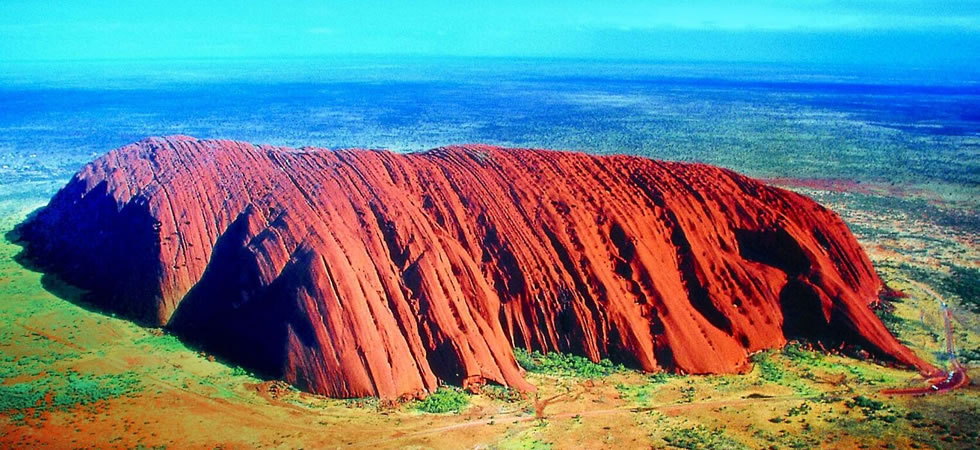Sue Tidy gives us an in depth look at Uluru (also known as Ayers Rock), Australia’s most iconic and ancient landmark.
Visiting the remote red deserts of Australia is like travelling into a timeless zone of billion year old flora and fauna and geological wonders that you will find nowhere else on earth.
One of the most iconic examples of these is the red sandstone monolith known as Uluru/Ayers Rock. It rises out of the surrounding flat landscape as it has done for 700 million years and like so much of outback Australia is a sacred site for the Aborigines.
In 1985 the surrounding land was officially given back to the local aboriginal tribes (Anangu) and they lease the land back to Parks Australia and manage it jointly as the Uluru-Kata Tjuta National Park. This is done in such a way as to give visitors a truly unique experience whilst still preserving the integrity of the site.
Most visitors stay at the small purpose built eco friendly resort of Yulara 17km from Uluru and just outside the park limits. I went as part of an escorted tour of Australia and although more of a city girl, everyone I met who had been there said it was “ unmissable”.
Well, that did it, I had to see for myself what was so intriguing about what is essentially a big red rock in the middle of a desert!
There are several ways to appreciate Uluru and I picked 3 which each gave me a different perspective.
SUNSET
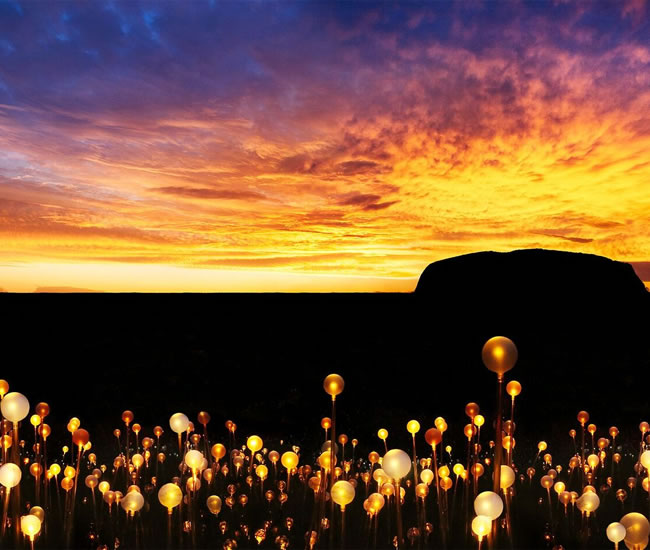
My first sight of Uluru was late afternoon and after driving through miles of flat desert scrub suddenly you are confronted with this mystical rock formation standing proud and timeless and inviting you to be impressed.
Sometimes I can read all about a place and think I am ready for it with all the facts and figures ( 1,142ft high, 5 miles round the base etc ) but nothing prepared me for the emotional impact.
I found it surprisingly moving, it was like seeing something you have always known on a subconscious level. It really does have the wow factor and I was immediately hooked.
Arriving at the viewing area ( known wryly as Sunset Strip ) we set up our tables, chairs and picnic. Other groups were doing the same and the whole atmosphere was friendly and relaxed as we anticipated what for many of us was the highlight of our visit.
Uluru has such an ancient stillness about it, a hypnotic quality that demands attention. As the sun set it cast shadows which changed the colour of the rock from orange to red and gave the impression of it glowing against the darkening sky.
We stayed for a good hour after sunset, sitting under a clear night twinkling with stars and soaking up the still night with the reassuring presence of Uluru as a mighty backdrop.
UP CLOSE AND PERSONAL
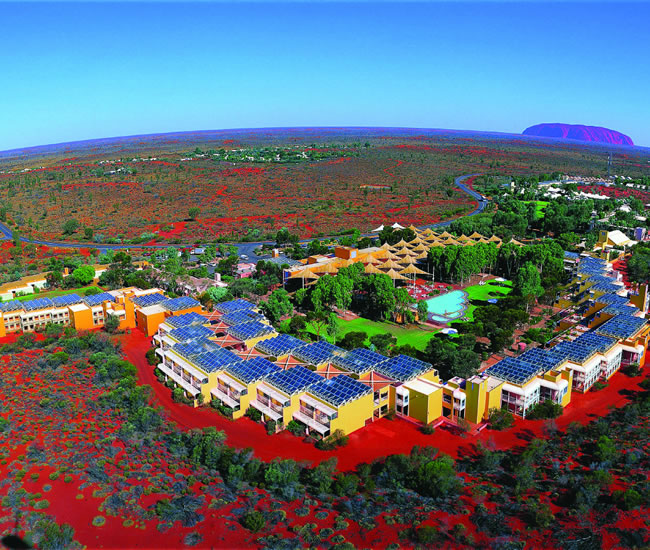
There is a small cultural centre about 2km from Uluru, run by the local people who live in a small community within the park and this is a great place to get an introduction to what the park has to offer.
The centre has a gallery, café and shops and several interesting displays explaining local flora and fauna, geology etc and of course the aboriginal Tjukurpa ( dreamtime ) beliefs.
These are quite complex and encompass the creation myths, the relation between all living things and the way to live and connect with the earth.
In simple terms the earth was featureless then ancestral spirit beings rose from the earth and formed the land with mountains, rivers etc which are connected by songlines or dreaming tracks.
The creators sang about the birds, animals and plants that they met and thus sang the world into existence! Each area has a song describing its features and by singing them in order you can navigate the land, so the songlines are a form of sacred ancient map.
It is believed that many beings returned to the earth as parts of the landscape and these are sacred sites. Each person has a special dreaming which is the spiritual identification of a person or object with a place or with a species of plant or animal.
From here I joined one of the guided tours of Uluru which took us around the base and I was immediately struck by how diverse it is up close. Not just a plain old rock but a mini eco system with springs, waterfalls, trees and caves with ancient paintings.
It is only the outer layer of the rock that is red, this is due to a type of rusting of the minerals and where the rock is fresh it has a silvery appearance. This along with all the crevices and ridges gives it a unique wavelike texture.
We had a good look around and the guide kept up a steady stream of information but as usual I missed most of the talks as I was off in my own world, musing over why I felt such an intense connection to the rock and wondering if I was the only one!
There is a sense of knowledge to Uluru, of eternal calm. Awe inspiring to think that this rock has been here since the age of the dinosaurs.
Photography is allowed in most areas but there were some restrictions at sacred sites which is fair enough. The aborigines still perform rituals here as they have done for thousands of years and we were told that many plants and animals are central to their beliefs and have their own ceremonies.
There are also practical uses for many of the local plants, for instance the bloodwood tree which yields wood used for boomerangs and spearheads and sap used as a disinfectant and inhalant for coughs!
After lunch in the café our group drove 25km to the west to visit the other main attraction of the park. Kata Tjuta (meaning “many heads”) is another huge rock formation made up of 36 rounded domes separated by impressive valleys and gorges.
Although it shares the reddish look of Uluru, It has a different geological makeup, there is more of a mix of rock types including granite and basalt. It is very sacred land and visitors are only permitted to walk on set paths.
There are two main walks, one is called the valley of the winds and takes about 3 hours, and there is also a 1 hour walking trail which takes you through Walpa Gorge .
Both are across rocky uneven ground and quite steep so maybe not accessible to the less mobile (or those with bad knees like myself!) so after a quick explore of the base rocks I repaired to a thatched shelter at the base.
Several other visitors were there and it felt like the most natural place to gather and talk. We discussed the dreamtime beliefs and how it is hard for the aborigines to explain to us what it means to them. They understand the innate connection between the land, people, animals and plants in a way that we never can.
Some people admitted that they were feeling intrigued at the pull that Uluru had on them on a subconscious level. We didn’t know how to relate to these experiences or what we were feeling or why.
You definitely get the sense that somewhere along the line most of us with our cities and technology have lost the ability to connect with our planet in a way that makes sense.
FROM THE AIR
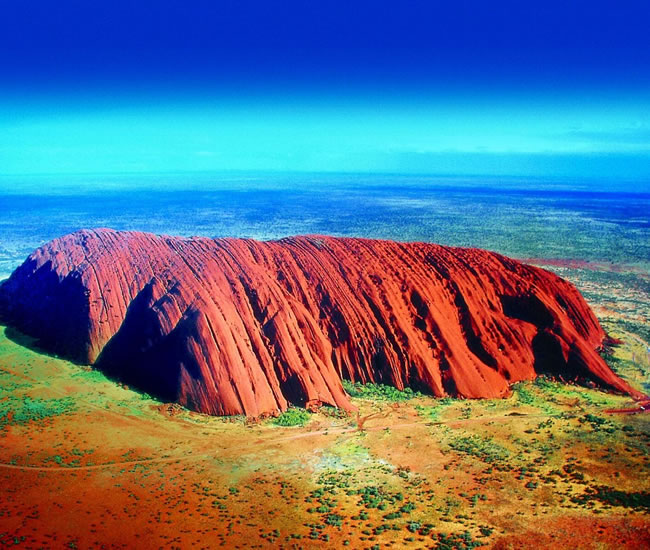
For a completely different perspective this cannot be beaten. There are several flight options to choose from and I went for the 30 minute helicopter sunset flight as even the magic of the sun rising over Uluru wasn’t going to get me out of bed at 4am!
From the airstrip at Yulara we flew over low ridges of green shrubs for several miles then as the sun began to set we swooped over Kata Tjuta and got a clear view of the meandering gorges and valleys. It is like a mountain range sat down in the desert.
Then in the distance you see the solitary Uluru lit up like an orange beacon casting its huge shadow across the darkening earth. Flying over it is absolutely stunning. You really feel as if you are witnessing something very special.
We only see part of Uluru as most of it is underground. Although it is unknown as to how far it extends, it has been estimated at up to 6km. This just adds to its whole aura of mystery!
The whole 30 minute flight really gave us a unique aspect of the spectacular formations of Uluru and Kata Tjuta and how remote and unique they are popped up like that in the middle of all that scrub.
What struck me was the different shapes and patterns made from the trees and plants dotted about against the red earth. It reminded me of the aboriginal artwork we had seen and I realised that what I was looking at were the natural features that these images represented.
An unforgettable experience which really finished off my trip to this serene and magical part of Australia.
SUMMING UP
There is a lot to see in Australia but no visit to this diverse and unique country would be complete without visiting its most iconic natural wonder. Go and see it for yourself, let it weave its ancient magic, I promise you wont regret it. Or ever forget it.
TOP TIPS
- A fly net for your hat is a must unless you actually like flies in your ears and nose!
- Get to viewing areas for sunrise and sunset early as they tend to fill up in high season.
- At sunrise and sunset take pictures every couple of minutes to capture the subtle changes of colour and light.
- In summer it is recommended that you complete any walks by 11am. This is due to extreme heat and some portions of the walks may be cordoned off.
- It is not forbidden to climb the rock but this crosses a sacred dreamline and out of respect it is asked that you do not do so.
- Please ask permission before taking photos of the local people.
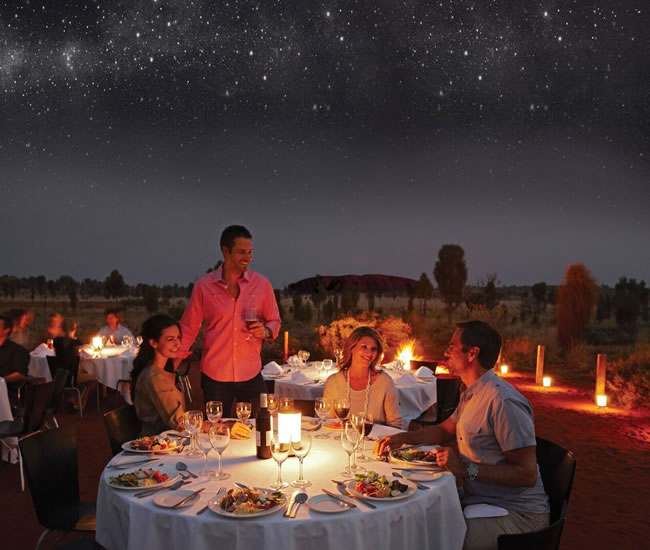
I travelled with Titan Tours. For more details, visit titantravel.co.uk
For more information, visit parksaustralia.gov.au/uluru/ and voyages.com.au – who kindly supplied all the images in this article.












